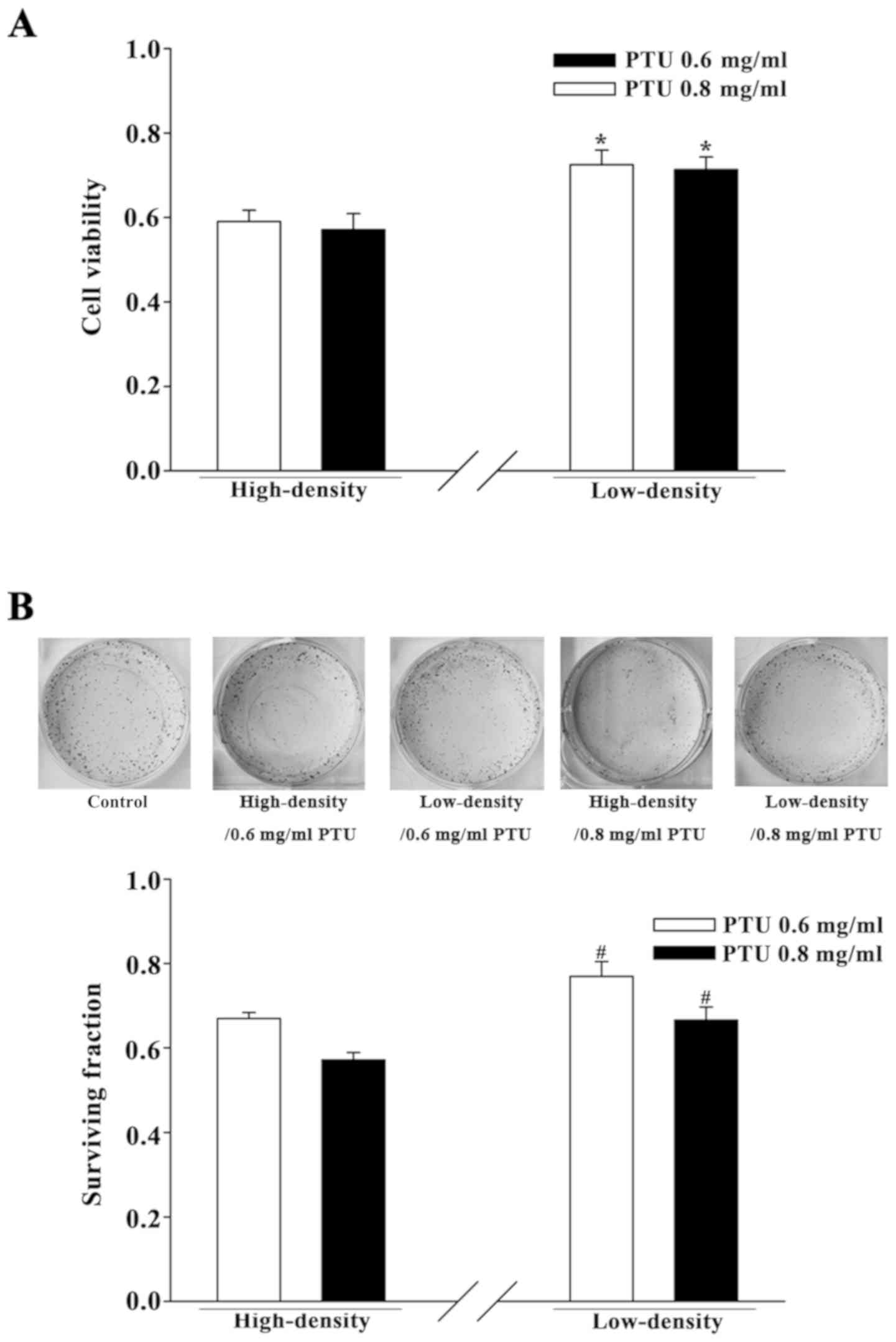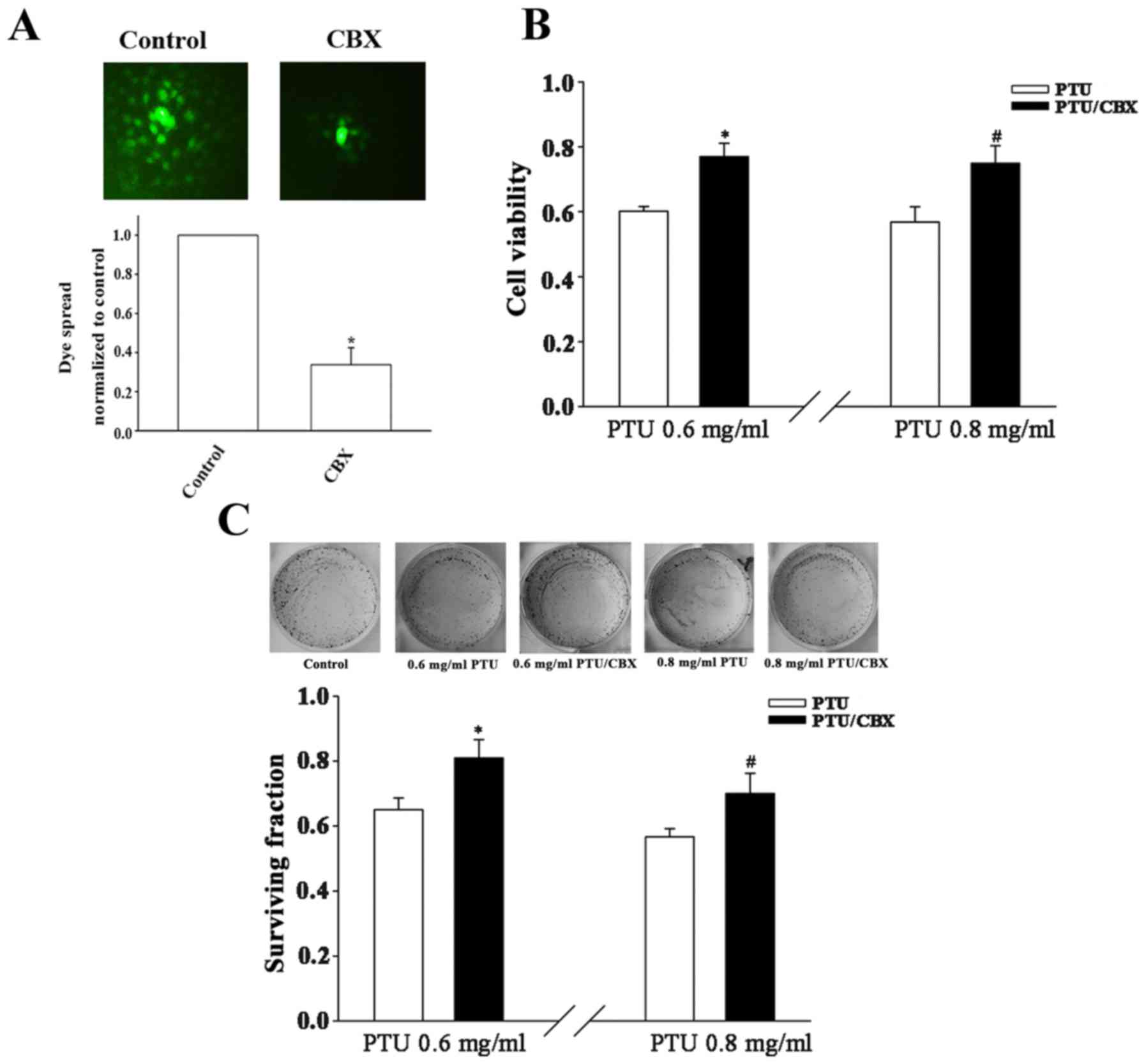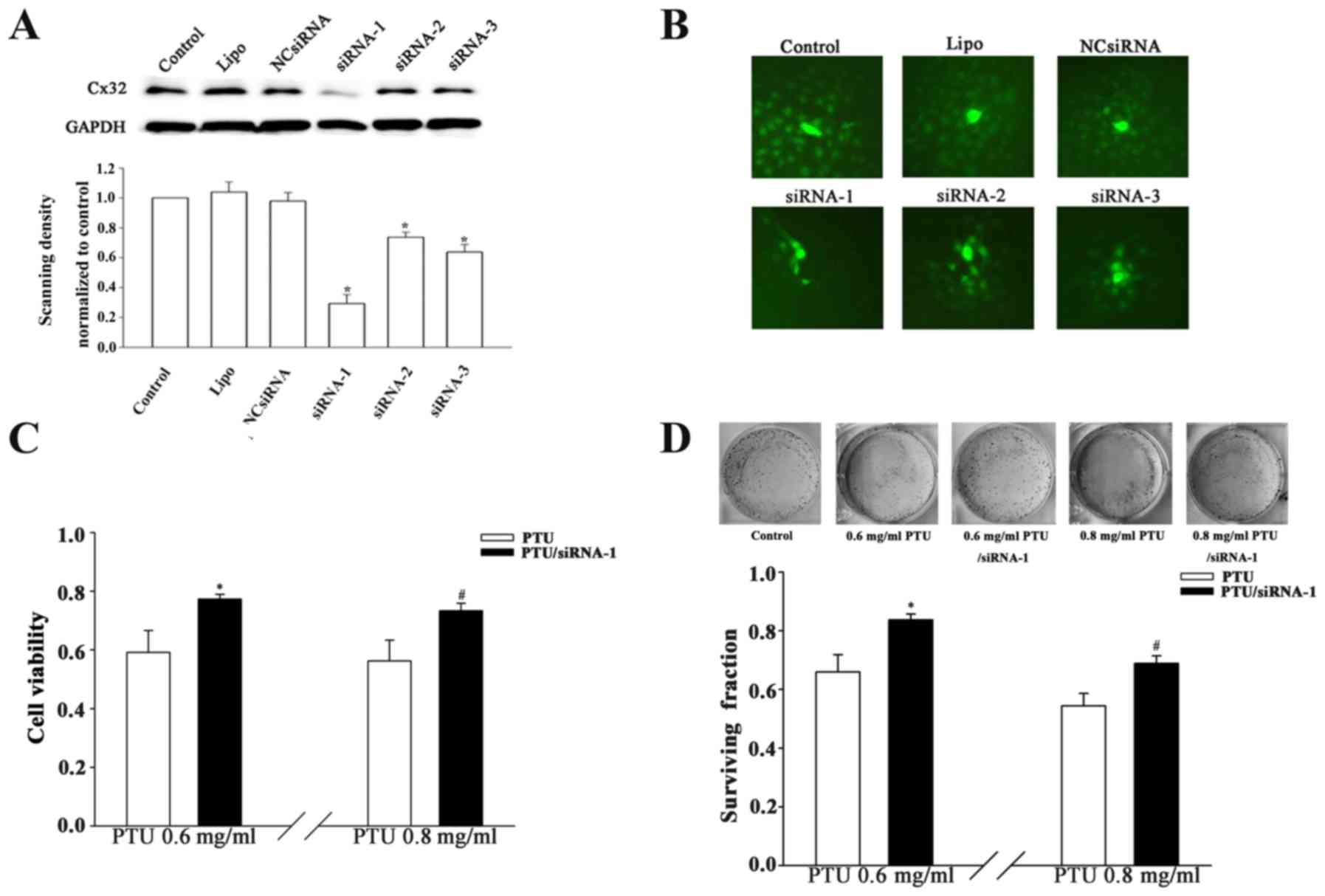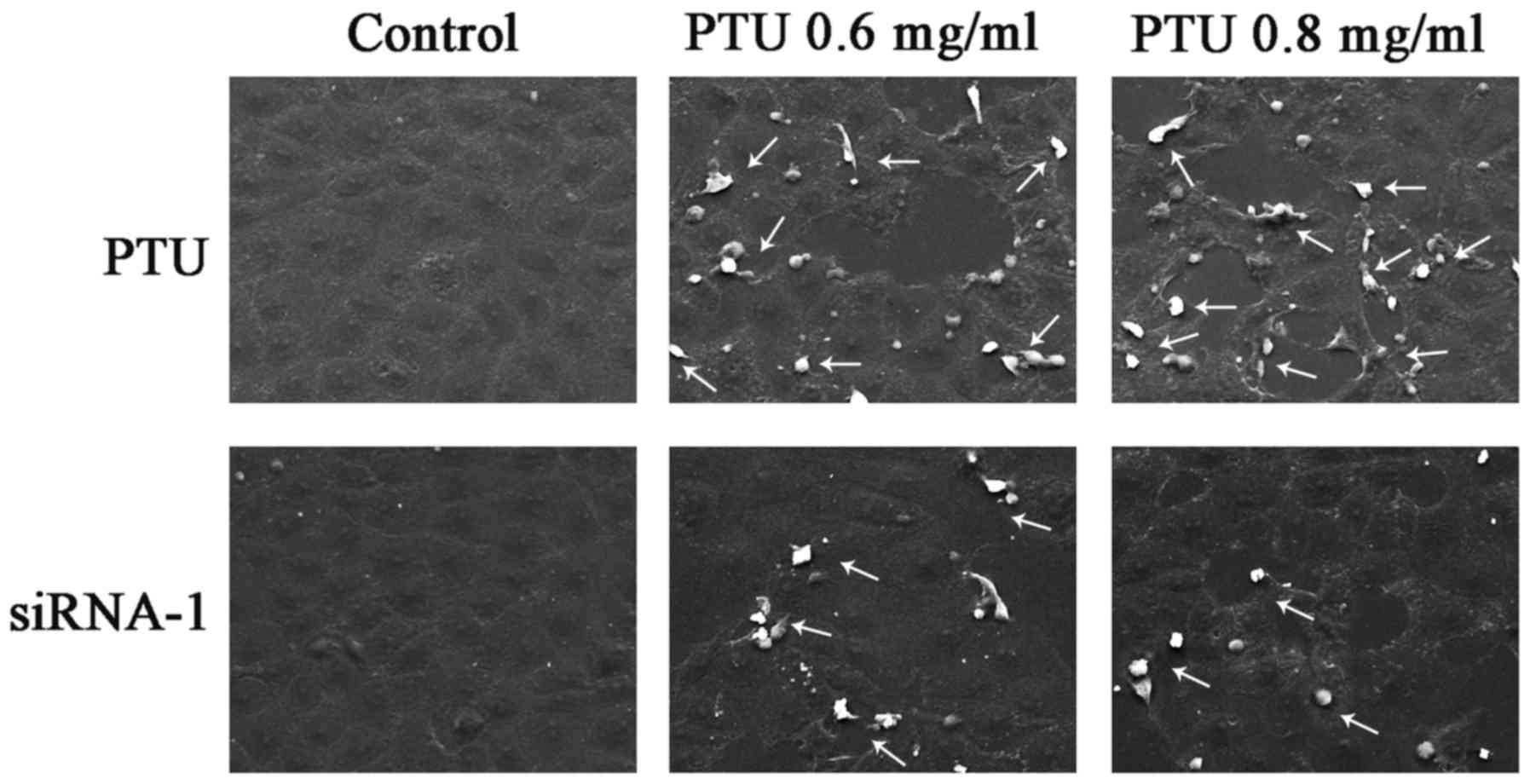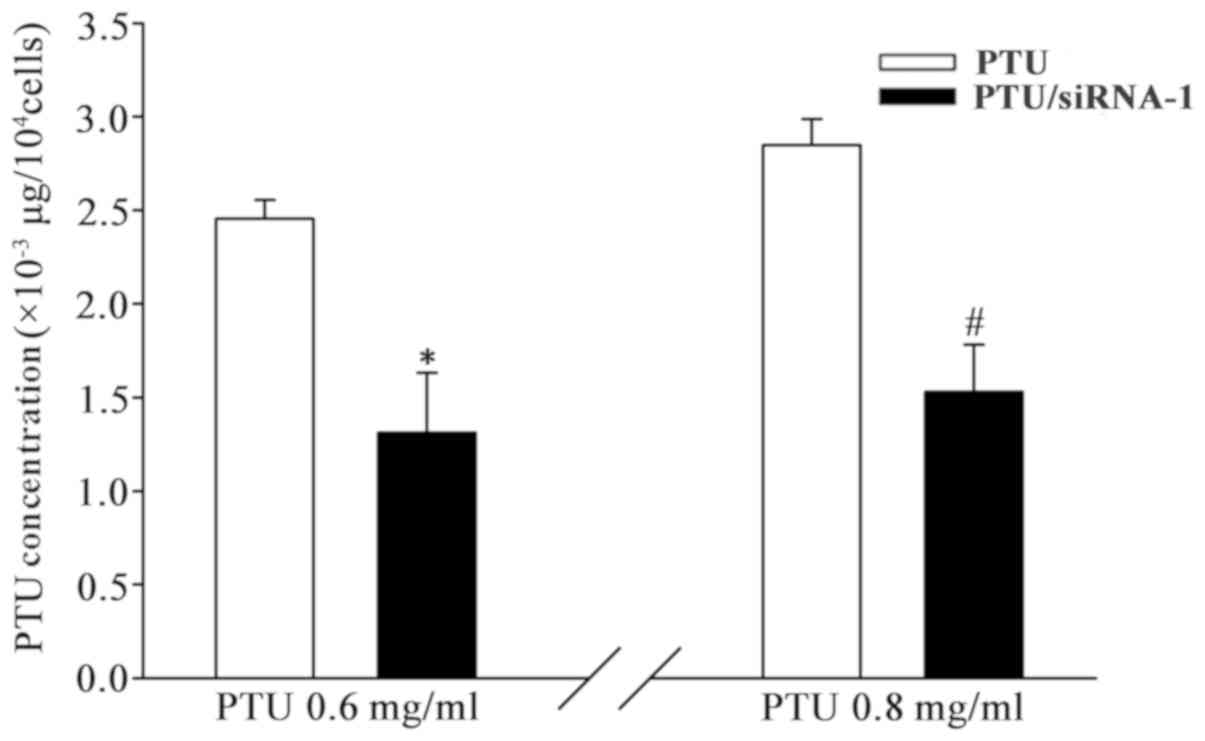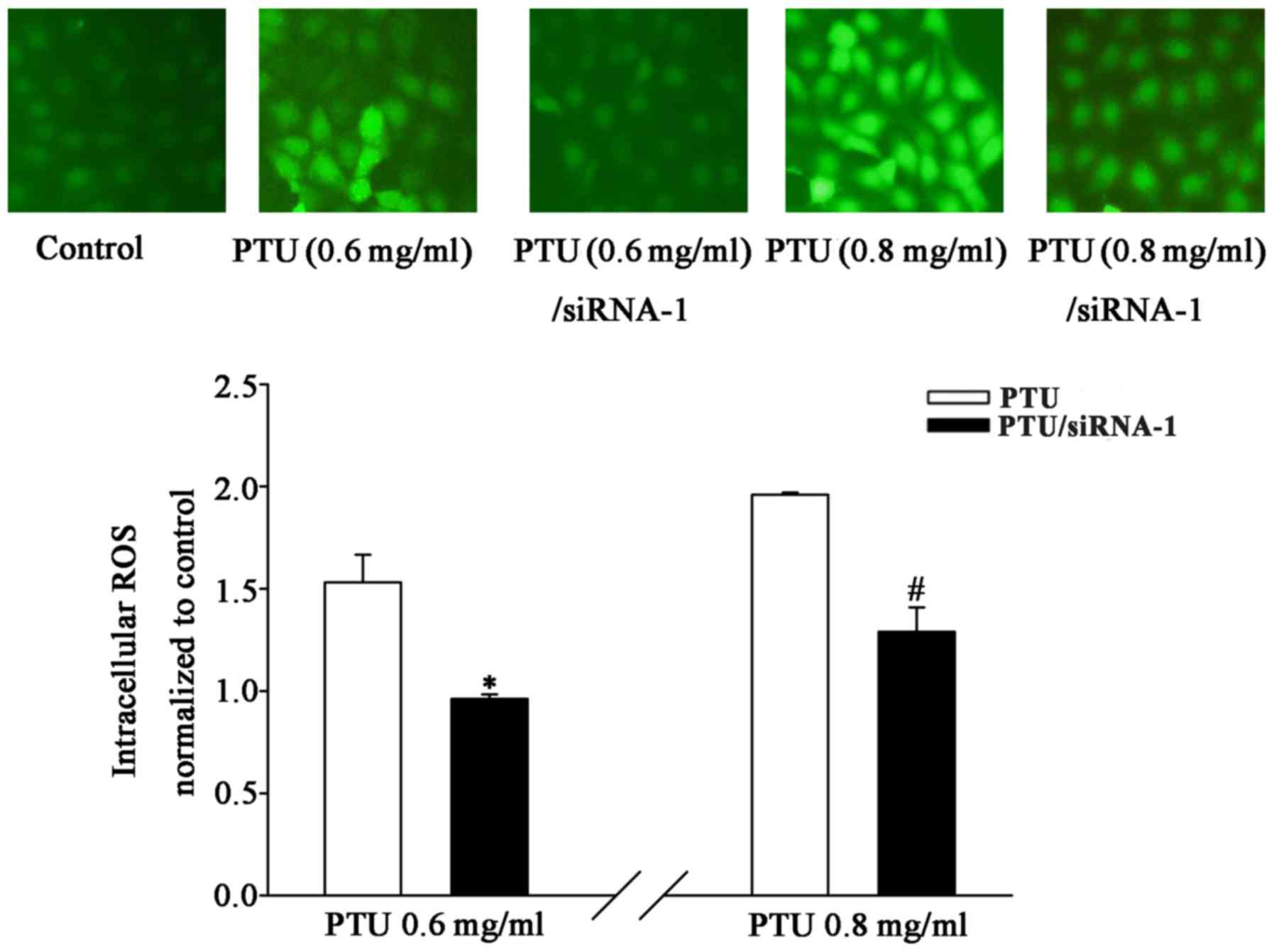Involvement of gap junctions in propylthiouracil‑induced cytotoxicity in BRL‑3A cells
- Authors:
- Published online on: February 6, 2019 https://doi.org/10.3892/etm.2019.7244
- Pages: 2799-2806
Abstract
Introduction
The Food and Drug Administration (FDA) approved propylthiouracil (PTU) for the treatment of Graves' disease in 1947 (1). In nearly 70 years of clinical application, reports of PTU-associated liver injury and failure, and even fatality, have accumulated for adult and pediatric patients (2–6). A warning regarding the potential risk of severe hepatic injury associated with PTU was issued by the FDA in 2009 (7). Therefore, it is recommended that patients receiving PTU therapy have their liver function closely monitored. PTU-induced liver injury primarily manifests as differing degrees of hepatocyte necrosis (8); however, the underlying mechanisms are largely unknown.
Gap junctions (GJs) directly connect the cytoplasm of adjacent cells, mediating the intercellular transmission of signaling molecules. Six transmembrane connexin (Cx) monomers are arranged in a circle to form a hemichannel, and then two hemichannels from neighboring plasma membranes are docked to form the GJ (9,10). Cx expression is distinct in a variety of tissues, and Cx32 is the major GJ protein in hepatocytes (11,12).
GJ-mediated intercellular communication (GJIC) is involved in a number of physiological and pathological processes (13–15). Previous reports have suggested a role for GJ channels in drug-induced liver injury (DILI) (16–18). Downregulation of GJs composed of Cx32 (Cx32-GJs) could reduce the hepatotoxicity of acetaminophen, D-galactosamine and carbon tetrachloride (19,20). Likewise, propofol protects rat liver cells from sevoflurane-induced cytotoxicity through inhibiting GJ channels (21). Based on this evidence, the inhibition of hepatic Cx32-GJs could prove to be an effective strategy for controlling DILI. However, whether this GJ-mediated hepatoprotection is effective against PTU toxicity, and the potential underlying mechanism of this, remain unknown. In the present study, the role and underlying mechanisms of GJs in PTU-induced toxicity were explored in BRL-3A cells.
Materials and methods
Materials
PTU, carbenoxolone (CBX), anti-GAPDH and secondary antibodies for western blotting were obtained from Sigma-Aldrich (Merck KGaA, Darmstadt, Germany). Anti-Cx32 antibody was obtained from Santa Cruz Biotechnology, Inc. (Dallas, TX, USA). Cell culture reagents, Lipofectamine 2000 and calcein acetoxymethyl ester (Calcein-AM) were purchased from Thermo Fisher Scientific, Inc. (Waltham, MA, USA). The Cell Counting kit-8 (CCK-8) was obtained from Dojindo (Mashikimachi, Kumamoto, Japan). The 2′,7′-dichlorofluorescin diacetate (DCFH-DA) was from Beyotime Institute of Biotechnology (Haimen, China). All other reagents and chemicals were obtained from Sigma-Aldrich; Merck KGaA, unless otherwise stated.
Cell culture
The BRL-3A rat liver cell line was purchased from the Cell Bank of the Chinese Academy of Sciences (Shanghai, China). Cells were cultivated in Dulbecco's modified Eagle's medium supplemented with 10% fetal bovine serum and 100 U/ml penicillin-streptomycin at 37°C in an atmosphere containing 5% CO2.
CCK-8 assay
Direct toxicity was determined using a CCK-8 kit according to the manufacturer's instructions. First, BRL-3A cells were subjected to 0.6 and 0.8 mg/ml PTU for 24 h at 37°C, after which they were incubated with 10% (v/v) CCK-8 reagent at 37°C for 3 h. The absorbance was read using a microplate reader (BioTek Instruments, Inc., Winooski, VT, USA) at a wavelength of 450 nm. The cell viability was normalized against that of the vehicle control.
A standard colony-formation assay
A standard colony-formation assay was used for detecting the cytotoxicity of PTU to BRL-3A cells (22). Briefly, following exposure to PTU at 0.6 and 0.8 mg/ml for 12 h, cells were rinsed with phosphate-buffered saline (PBS), harvested with trypsin, diluted and seeded into 6-well plates at a density of 500 cells/well. Cells were subsequently stained with 4% crystal violet at room temperature 5–7 days later. Colonies consisting of ≥50 cells were counted. The surviving fraction was evaluated by normalizing to the colony-forming efficiency of the vehicle-treated cells.
Small interfering (si)RNA transfection
Cx32 expression was inhibited by siRNA transfection in BRL-3A cells. The siRNA sequences targeted against the rat Cx32 gene were as described previously (23,24): siRNA-1, 5′-CACCAACAACACATAGAAA-3′; siRNA-2, 5′-GCATCTGCATTATCCTCAA-3′; and siRNA-3, 5′-GCCTCTCACCTGAATACAA-3′. Cx32 siRNAs (50 nM) or the negative control siRNA (NC siRNA) were transiently transfected into BRL-3A cells using Lipofectamine 2000, according to the manufacturer's instructions. After 48 h incubation, western blotting and a ‘parachute’ assay, as described below, were performed to confirm Cx32 expression knockdown and GJIC inhibition.
Western blotting
The procedure of western blotting was performed as described previously (25). In brief, cell lysates were obtained in lysis buffer (P0013; Beyotime Institute of Biotechnology), sonicated and centrifuged at 14,167 × g at 4°C for 30 min. Protein concentration was determined by BCA assay. Cell lysates (20 µg per lane) were separated using SDS-PAGE in 10% Tris-glycine gels and transferred to nitrocellulose membranes. Following blocking with 5% skimmed dry milk in Tris buffered saline with Tween-20 (0.05% Tween-20) at room temperature for 1 h, the membranes were incubated with specific antibodies against Cx32 (sc-59948; dilution, 1:1,000) and GAPDH (G8795; dilution, 1:2,000) overnight at 4°C. Secondary antibodies (goat anti-mouse IgG-peroxidase conjugated; A4416; dilution, 1:4,000) were then added at room temperature for 1 h. The immunopositive protein bands were visualized using an Amersham Enhanced Chemiluminescence Detection kit (GE Healthcare Life Sciences, Little Chalfont, UK) and the intensities were detected by the Quantity One software (Bio-Rad, version 4.6.2).
‘Parachute’ dye-coupling assay
A ‘parachute’ dye-coupling assay was performed to evaluate GJ function as previously described (26). Cells were seeded into 12-well plates and cultured to 80–90% confluency. Donor cells from one well were labeled with 5 µM Calcein-AM and trypsinized, diluted and seeded onto receiver cells at a ratio of 1:150 (donor/receiver). GJs formed between donor cells and receiver cells during a 4-h incubation at 37°C and were monitored using an Olympus IX71 fluorescence microscope (Olympus Corporation, Tokyo, Japan). Under each experimental condition (treatment of CBX or (si)RNA transfection), the average number of receiver cells containing calcein dye per donor cell was counted and normalized to that of the vehicle control.
Observation of cell morphology
Cell morphology was observed using a FEI Quanta-400 scanning electron microscope (SEM; Thermo Fisher Scientific, Inc.). Sterile slides were placed in 12-well plates and served as substrates. Cells were treated with vehicle control or PTU at 0.6 and 0.8 mg/ml for 24 h, rinsed with PBS and fixed in 4% paraformaldehyde for 1 h at room temperature. Following gradient dehydration in a series of ethanol from 30–100%, the samples were dried in a vacuum freeze-drying apparatus for 1 h and were treated with gold sputtering for SEM observation.
Detection of PTU concentration in BRL-3A cells
Reversed-phase high-performance liquid chromatography was adopted to measure the PTU content in BRL-3A cells (27). Briefly, following incubation with PTU at 0.6 and 0.8 mg/ml for 24 h, cells were washed with PBS three times, harvested by trypsinization, resuspended in PBS and counted. Five freeze-thaw cycles were used to lyse the cells. Methanol (HPLC-grade) was added for protein precipitation. Following centrifugation at 14,167 × g for 10 min at 4°C, the supernatant was collected and injected into a Shimadzu LC-20AD system (Shimadzu Corporation, Kyoto, Japan). The chromatographic conditions used were as follows: Application of a Luna C18 column (250×4.6 mm; 5mm; Phenomenex, Torrance, CA, USA), methanol and water (40:60) was used as the mobile phase at a flow rate of 1.0 ml/min, which was detected at a wavelength of 272 nm with a column temperature of 30°C. The concentrations of PTU in the cell samples were calculated using a calibration curve method.
Analysis of intracellular reactive oxygen species (ROS) levels
Following exposure to PTU at 0.6 and 0.8 mg/ml for 6 h, BRL-3A cells were labeled with DCFH-DA, which is hydrolyzed by esterase into DCFH without fluorescence. Intracellular ROS can oxidize non-fluorescent DCFH to fluorescent DCF (28). Formation of DCF was determined using a Perkin LS55 fluorescence spectrophotometer (PerkinElmer Inc., Waltham, MA, USA) with an excitation wavelength of 488 nm and an emission wavelength of 525 nm. Fluorescence intensity was normalized to that of the vehicle control and was regarded as a measure of the intracellular ROS level. The DCF images were captured via fluorescence microscopy (Olympus IX71; Olympus Corporation).
Statistical analysis
The data were presented as the mean ± standard error and were analyzed using IBM SPSS Statistics 19.0 (Armonk, NY, USA). Statistical analysis was performed by Student's t-test or one-way analysis of variance followed by Dunnett's test. In all cases, P<0.05 was considered to indicate a statistically significant difference.
Results
Cell density influences the cytotoxic effect of PTU in BRL-3A cells
BRL-3A cells were cultured separately under two cell-density conditions for initial investigation of the influence of GJIC on PTU toxicity. At a high cell density (2×104 cells per cm2), GJs formed efficiently as the cells had frequent contact with one another. At a low cell density (5×103 cells per cm2), the wide dispersion of cells infrequently permitted the formation of GJs. A preliminary cell viability assay for concentrations screening was performed with PTU from 0.3 to 0.8 mg/ml (data not shown). The concentrations of 0.6 and 0.8 mg/ml PTU were chosen in the present study. PTU-induced cytotoxicity was assessed using a CCK-8 assay and a standard colony-formation assay. Fig. 1 illustrates that PTU treatment, at concentrations of 0.6 and 0.8 mg/ml, decreased the cell survival of BRL-3A cells under both culture conditions. However, the survival was significantly greater in the low-density condition compared with the high-density condition. Thus, the toxicity of PTU in BRL-3A cells was reduced under low cell-density conditions wherein there was a deficiency in GJIC.
Pharmacological inhibition of GJ function decreases PTU cytotoxicity in BRL-3A cells
To investigate whether the cell density-dependence of PTU toxicity in BRL-3A cells is associated with GJIC, an extensive GJ inhibitor, CBX (29), was adopted to manipulate GJ function. BRL-3A cells were pretreated with the CBX prior to exposure to PTU. In a subsequent ‘parachute’ assay, dye-coupling was significantly blocked by CBX pretreatment (Fig. 2A). Under high cell-density culture conditions, the cell survival was significantly increased following pretreatment with 100 µM CBX for 1 h at PTU concentrations of 0.6 and 0.8 mg/ml, as compared with PTU alone (Fig. 2B and C). These results indicate that the inhibition of GJs contributes to the decreased toxicity of PTU at high BRL-3A cell densities.
Suppression of Cx32-GJ function by Cx32 knockdown attenuates PTU cytotoxicity
Cx32 is a key GJ constituent protein in liver cells (12). Specific knockdown of the Cx32 gene was conducted to confirm the effect of Cx32-GJ on PTU cytotoxicity. As indicated in Fig. 3A and B, the downregulation of Cx32 expression significantly suppressed the spread of calcein dye through GJs in siRNA-transfected cells. Furthermore, Cx32-knockdown (siRNA-1 transfection) increased the cell viability by factors of 1.31 and 1.29 in the presence of 0.6 and 0.8 mg/ml PTU, respectively, at high cell densities (Fig. 3C). Likewise, clonogenic capacity was improved at these two concentrations when Cx32-GJs were inhibited (Fig. 3D). The results indicate that Cx32-GJ serves an important role in the PTU-induced cytotoxicity of BRL-3A cells.
Cx32-GJs influence cell morphology and necrosis
PTU has been demonstrated to induce necrosis in liver injury (8). To assess the necrosis of BRL-3A cells subjected to PTU in the absence of Cx32-GJ, SEM images were captured. Fig. 4 illustrates the typical morphological characteristics of cell necrosis, including cell swelling and spillovers of cellular content (as indicated by the arrows), which were clearly noted following PTU treatment, but were less obvious following siRNA-mediated Cx32-GJ inhibition. These results suggest that the suppression Cx32-GJ attenuates PTU hepatotoxicity, which is partly associated with a decrease in PTU-induced necrosis.
Inhibition of Cx32-GJ decreases intracellular PTU accumulation
GJs facilitate direct intercellular communication between neighboring cells. PTU, as a small molecule, could be transmitted through GJs. To assess whether the PTU concentration in BRL-3A cells could be reduced by blocking Cx32-GJ function, the intracellular PTU content was determined. As indicated in Fig. 5, the level of cellular PTU [PTU (µg) per 104 cells] significantly decreased when cells were transfected with Cx32 siRNA-1. The reduction of PTU uptake in BRL-3A cells between those with and without Cx32-GJ were significant at 0.6 and 0.8 mg/ml PTU. These results demonstrate that PTU accumulation is reduced when Cx32-GJ is downregulated.
Inhibition of Cx32-GJ prevents ROS transmission
To investigate the possibility of ROS transmission through GJs, intracellular ROS levels in the presence and absence of Cx32-GJ were detected. The results revealed that PTU-induced toxicity was accompanied by an increase in ROS production at concentrations ≤0.8 mg/ml. Fig. 6 illustrates that Cx32 siRNA-1 transfection markedly suppressed the PTU-induced increase in DCF fluorescence, which was quantified by fluorescence spectrophotometry. The levels of intracellular ROS were significantly reduced in the Cx32-knockdown group at PTU concentrations of 0.6 and 0.8 mg/ml. These findings suggest that the attenuation of PTU-induced toxicity by Cx32-GJ downregulation may be associated with the inhibition of ROS transmission.
Discussion
In the present study, it was demonstrated that PTU-induced toxicity depends on GJs in BRL-3A cells. The investigation indicated that the inhibition of GJs could protect against PTU-induced liver cell damage in vitro. Furthermore, PTU-induced necrosis was decreased following specific blocking of Cx32-GJs. Results from the current study illustrated that inhibition of GJ has a protective effect in PTU-induced liver toxicity and that GJ-attenuated cytotoxicity is associated, in part, with the reduction of necrosis.
Recent studies have demonstrated that the inhibition of hepatic Cx32-GJs can attenuate the liver toxicity associated with various types of drugs, suggesting a promising new therapeutic target for DILI (19,20). An ‘injury signal’ responsible for inducing apoptosis or necrosis diffuses through GJ channels to cause damage or death in the adjacent cells, which is known as the ‘bystander effect’. This effect has been observed in herpes simplex virus thymidine kinase and in the radiotherapy of cancer (30–32). In DILI, blocking the propagation of ‘injury signals’ among cells through Cx32-GJ may be key to this hepatoprotective effect. The ‘injury signals’ mediated by GJs have been widely investigated, particularly in carcinoma cells (25,33). However, their intrinsic properties have not been identified. The relevant signals are considered to be the drugs or their toxic metabolites, calcium, inositol 1,4,5-triphosphate (IP3), or other signaling molecules triggering cell damage (34–37).
There are ~21 Cx isoforms in mammals, which assemble into junction channels with selective permeability to molecules (9). For example, Cx32-GJs exhibit higher permeability to adenosine, cAMP and IP3 than do Cx43-GJs, while ATP is conducted through Cx43-GJs more effectively than through Cx32-GJs (38–40). In the present work, inhibition of GJ function using extensive GJ blocker (CBX) and Cx32 siRNAs decreases PTU cytotoxicity, in which Cx32-GJ have an essential role on this hepatoprotective effect. Therefore, in the present study, the possible ‘injury signals’ transmitted through Cx32-GJs should have the following characteristics: i) The ability to permeate through Cx32 channels; and ii) the ability to influence the cytotoxicity of PTU. It was considered that PTU and ROS are the potential ‘injury signals’ involved in Cx32-GJ-mediated PTU toxicity.
The molecular weight of PTU is 170.2 Da, which is less than the limit for passage through GJ channels (1–2 kDa); therefore, it could be transferred via GJs by passive diffusion. Furthermore, PTU could markedly suppress glutathione S-transferase (GST) activity to interfere with the antioxidation of glutathione (41). Therefore, the present study was performed to investigate the possibility that PTU is a GJ-permeable ‘injury signal’. The results indicated that PTU uptake was decreased in cells deficient in functional Cx32 channels. This decline may not only be conducive to the restoration of GST activity; it may also weaken allergic responses caused by PTU acting as a hapten.
Oxidative stress was observed in hypothyroid rats induced by administration of drinking water containing 0.05% PTU for 8 weeks (42,43). Oxidative stress is an important pathophysiological basis of liver injury, in which ROS is the essential mediator; it induces lipid peroxidation of the cellular and mitochondrial membranes, causing changes in permeability and affecting signal transduction pathways (e.g., ROS/Protein kinase C, ROS/c-Jun N-terminal kinase (44–46). Previous studies identified that ROS can spread through Cx32 channels, acting as toxic molecules (19,47). The experimental results in the present study suggested that ROS induced by PTU-exposure were regulated by Cx32-GJs. Rat hepatocytes deficient in Cx32 could prevent the passage of ROS between cells. Thus, ROS could be PTU-induced ‘injury signals’ with selective Cx32 channel permeability.
Immortalized BRL-3A cells endogenously expressing Cx32 and Cx43 is a simple model for investigating the role of GJ in PTU-induced hepatotoxicity in vitro. However, the limitations of using only one rat liver cell line are the differences in species and primary hepatocytes (such as confounding factors arising from the complicated hemodynamic system), the effects of GJs on the PTU-induced cytotoxicity in human hepatocytes, and in vivo, remain to be explored.
In conclusion, the role of GJs in PTU-induced cytotoxicity was investigated in BRL-3A cells. The results indicated that the suppression of Cx32-GJ channels protected against PTU-cytotoxicity through reducing necrosis. Furthermore, PTU and ROS appeared to affect the Cx32-GJ-mediated hepatoprotective effect, acting as ‘injury signals’.
Acknowledgements
Not applicable.
Funding
The present study was supported by the National Natural Science Foundation of China (grant no. 81400619), the Scientific Research Project of Education Department of Guangdong Province (grant no. 2017KTSCX079), the Funding for College Students' Science and Technology Innovation and Cultivation of Guangdong Province (grant no. pdjhb0220).
Availability of data and materials
All data generated or analyzed during this study are included in this published article.
Authors' contributions
NT designed the current study. NT, ZC, HC, LC and BC performed the experiments. NT, ZC and BL analyzed the data. All authors have read and approved the final manuscript.
Ethics approval and consent to participate
Not applicable.
Patient consent for publication
Not applicable.
Competing interests
The authors declare that they have no competing interests.
References
|
Landau RL: Landmark perspective: Treatment of hyperthyroidism. JAMA. 251:1747–1748. 1984. View Article : Google Scholar : PubMed/NCBI | |
|
Glinoer D and Cooper DS: The propylthiouracil dilemma. Curr Opin Endocrinol Diabetes Obes. 19:402–407. 2012. View Article : Google Scholar : PubMed/NCBI | |
|
Malozowski S and Chiesa A: Propylthiouracil-induced hepatotoxicity and death. Hopefully, never more. J Clin Endocrinol Metab. 95:3161–3163. 2010. View Article : Google Scholar : PubMed/NCBI | |
|
Yang J, Li LF, Xu Q, Zhang J, Weng WW, Zhu YJ and Dong MJ: Analysis of 90 cases of antithyroid drug-induced severe hepatotoxicity over 13 years in China. Thyroid. 25:278–283. 2015. View Article : Google Scholar : PubMed/NCBI | |
|
Wang MT, Lee WJ, Huang TY, Chu CL and Hsieh CH: Antithyroid drug-related hepatotoxicity in hyperthyroidism patients: A population-based cohort study. Br J Clin Pharmacol. 78:619–629. 2014. View Article : Google Scholar : PubMed/NCBI | |
|
Wu DB, Chen EQ, Bai L and Tang H: Propylthiouracil-induced liver failure and artificial liver support systems: A case report and review of the literature. Ther Clin Risk Manag. 13:65–68. 2017. View Article : Google Scholar : PubMed/NCBI | |
|
Bahn RS, Burch HS, Cooper DS, Garber JR, Greenlee CM, Klein IL, Laurberg P, McDougall IR, Rivkees SA, Ross D, et al: The role of propylthiouracil in the management of graves' disease in adults: Report of a meeting jointly sponsored by the american thyroid association and the food and drug administration. Thyroid. 19:673–674. 2009. View Article : Google Scholar : PubMed/NCBI | |
|
Williams KV, Nayak S, Becker D, Reyes J and Burmeister LA: Fifty years of experience with propylthiouracil-associated hepatotoxicity: What have we learned? J Clin Endocrinol Metab. 82:1727–1733. 1997. View Article : Google Scholar : PubMed/NCBI | |
|
Maeda S and Tsukihara T: Structure of the gap junction channel and its implications for its biological functions. Cell Mol Life Sci. 68:1115–1129. 2011. View Article : Google Scholar : PubMed/NCBI | |
|
Sosinsky GE and Nicholson BJ: Structural organization of gap junction channels. Biochim Biophys Acta. 1711:99–125. 2005. View Article : Google Scholar : PubMed/NCBI | |
|
Harris AL: Emerging issues of connexin channels: Biophysics fills the gap. Q Rev Biophys. 34:325–472. 2001. View Article : Google Scholar : PubMed/NCBI | |
|
Koffler LD, Fernstrom MJ, Akiyama TE, Gonzalez FJ and Ruch RJ: Positive regulation of connexin32 transcription by hepatocyte nuclear factor-1alpha. Arch Biochem Biophys. 407:160–167. 2002. View Article : Google Scholar : PubMed/NCBI | |
|
Zoidl G and Dermietzel R: Gap junctions in inherited human disease. Pflugers Arch. 460:451–466. 2010. View Article : Google Scholar : PubMed/NCBI | |
|
Scott DA, Kraft ML, Stone EM, Sheffield VC and Smith RJ: Connexin mutations and hearing loss. Nature. 391:321998. View Article : Google Scholar : PubMed/NCBI | |
|
Belousov AB, Fontes JD, Freitas-Andrade M and Naus CC: Gap junctions and hemichannels: Communicating cell death in neurodevelopment and disease. BMC Cell Biol. 18 (Suppl 1):42017. View Article : Google Scholar : PubMed/NCBI | |
|
Park WJ, Park JW, Erez-Roman R, Kogot-Levin A, Bame JR, Tirosh B, Saada A, Merrill AH Jr, Pewzner-Jung Y and Futerman AH: Protection of a ceramide synthase 2 null mouse from drug-induced liver injury: Role of gap junction dysfunction and connexin 32 mislocalization. J Biol Chem. 288:30904–30916. 2013. View Article : Google Scholar : PubMed/NCBI | |
|
Maurel M and Rosenbaum J: Closing the gap on drug-induced liver injury. Hepatology. 56:781–783. 2012. View Article : Google Scholar : PubMed/NCBI | |
|
Naiki-Ito A, Asamoto M, Naiki T, Ogawa K, Takahashi S, Sato S and Shirai T: Gap junction dysfunction reduces acetaminophen hepatotoxicity with impact on apoptotic signaling and connexin 43 protein induction in rat. Toxicol Pathol. 38:280–286. 2010. View Article : Google Scholar : PubMed/NCBI | |
|
Patel SJ, Milwid JM, King KR, Bohr S, Iracheta-Vellve A, Li M, Vitalo A, Parekkadan B, Jindal R and Yarmush ML: Gap junction inhibition prevents drug-induced liver toxicity and fulminant hepatic failure. Nat Biotechnol. 30:179–183. 2012. View Article : Google Scholar : PubMed/NCBI | |
|
Asamoto M, Hokaiwado N, Murasaki T and Shirai T: Connexin 32 dominant-negative mutant transgenic rats are resistant to hepatic damage by chemicals. Hepatology. 40:205–210. 2004. View Article : Google Scholar : PubMed/NCBI | |
|
Huang F, Li S, Gan X, Wang R and Chen Z: Propofol inhibits gap junctions by attenuating sevoflurane-induced cytotoxicity against rat liver cells in vitro. Eur J Anaesthesiol. 31:219–224. 2014. View Article : Google Scholar : PubMed/NCBI | |
|
Wang Q, You T, Yuan D, Han X, Hong X, He B, Wang L, Tong X, Tao L and Harris AL: Cisplatin and oxaliplatin inhibit gap junctional communication by direct action and by reduction of connexin expression, thereby counteracting cytotoxic efficacy. J Pharmacol Exp Ther. 333:903–911. 2010. View Article : Google Scholar : PubMed/NCBI | |
|
Tang N, Liu J, Chen B, Zhang Y, Yu M, Cai Z and Chen H: Effects of gap junction intercellular communication on the docetaxel-induced cytotoxicity in rat hepatocytes. Mol Med Rep. 15:2689–2694. 2017. View Article : Google Scholar : PubMed/NCBI | |
|
Wang R, Huang F, Chen Z and Li S: Downregulation of connexin 32 attenuates hypoxia/reoxygenation injury in liver cells. J Biochem Mol Toxicol. 29:189–197. 2015. View Article : Google Scholar : PubMed/NCBI | |
|
Hong X, Wang Q, Yang Y, Zheng S, Tong X, Zhang S, Tao L and Harris AL: Gap junctions propagate opposite effects in normal and tumor testicular cells in response to cisplatin. Cancer Lett. 317:165–171. 2012. View Article : Google Scholar : PubMed/NCBI | |
|
Zhang Y, Tao L, Fan L, Peng Y, Yang K, Zhao Y, Song Q and Wang Q: Different gap junction-propagated effects on cisplatin transfer result in opposite responses to cisplatin in normal cells versus tumor cells. Sci Rep. 5:125632015. View Article : Google Scholar : PubMed/NCBI | |
|
Tang N, Chen H, Cai Z, Zhan P, Pan T, Zhang Y and Wu X: Development and validation of RP-HPLC method for determination of propylthiouracil in hepatic cells. Curr Pharm Anal. 14:219–222. 2018. View Article : Google Scholar | |
|
Tian YY, An LJ, Jiang L, Duan YL, Chen J and Jiang B: Catalpol protects dopaminergic neurons from LPS-induced neurotoxicity in mesencephalic neuron-glia cultures. Life Sci. 80:193–199. 2006. View Article : Google Scholar : PubMed/NCBI | |
|
Davidson JS and Baumgarten IM: Glycyrrhetinic acid derivatives: A novel class of inhibitors of gap-junctional intercellular communication. Structure-activity relationships. J Pharmacol Exp Ther. 246:1104–1107. 1988.PubMed/NCBI | |
|
Vrionis FD, Wu JK, Qi P, Waltzman M, Cherington V and Spray DC: The bystander effect exerted by tumor cells expressing the herpes simplex virus thymidine kinase (HSVtk) gene is dependent on connexin expression and cell communication via gap junctions. Gene Ther. 4:577–585. 1997. View Article : Google Scholar : PubMed/NCBI | |
|
Hamada N, Matsumoto H, Hara T and Kobayashi Y: Intercellular and intracellular signaling pathways mediating ionizing radiation-induced bystander effects. J Radiat Res. 48:87–95. 2007. View Article : Google Scholar : PubMed/NCBI | |
|
Prise KM and O'Sullivan JM: Radiation-induced bystander signalling in cancer therapy. Nat Rev Cancer. 9:351–360. 2009. View Article : Google Scholar : PubMed/NCBI | |
|
Krutovskikh VA, Piccoli C and Yamasaki H: Gap junction intercellular communication propagates cell death in cancerous cells. Oncogene. 21:1989–1999. 2002. View Article : Google Scholar : PubMed/NCBI | |
|
Krysko DV, Leybaert L, Vandenabeele P and D'Herde K: Gap junctions and the propagation of cell survival and cell death signals. Apoptosis. 10:459–469. 2005. View Article : Google Scholar : PubMed/NCBI | |
|
Lin JH, Weigel H, Cotrina ML, Liu S, Bueno E, Hansen AJ, Hansen TW, Goldman S and Nedergaard M: Gap-junction-mediated propagation and amplification of cell injury. Nat Neurosci. 1:7431998. View Article : Google Scholar | |
|
Decrock E, Krysko DV, Vinken M, Kaczmarek A, Crispino G, Bol M, Wang N, De Bock M, De Vuyst E, Naus CC, et al: Transfer of IP3 through gap junctions is critical, but not sufficient, for the spread of apoptosis. Cell Death Differ. 19:947–957. 2012. View Article : Google Scholar : PubMed/NCBI | |
|
Decrock E, Vinken M, Bol M, D'Herde K, Rogiers V, Vandenabeele P, Krysko DV, Bultynck G and Leybaert L: Calcium and connexin-based intercellular communication, a deadly catch? Cell Calcium. 50:310–321. 2011. View Article : Google Scholar : PubMed/NCBI | |
|
Niessen H, Harz H, Bedner P, Krämer K and Willecke K: Selective permeability of different connexin channels to the second messenger inositol 1,4,5-trisphosphate. J Cell Sci. 113:1365–1372. 2000.PubMed/NCBI | |
|
Goldberg GS, Moreno AP and Lampe PD: Gap junctions between cells expressing connexin 43 or 32 show inverse permselectivity to adenosine and ATP. J Biol Chem. 277:36725–36730. 2002. View Article : Google Scholar : PubMed/NCBI | |
|
Bevans CG, Kordel M, Rhee SK and Harris AL: Isoform composition of connexin channels determines selectivity among second messengers and uncharged molecules. J Biol Chem. 273:2808–2816. 1998. View Article : Google Scholar : PubMed/NCBI | |
|
Kariya K, Sawahata T, Okuno S and Lee E: Inhibition of hepatic glutathione transferases by propylthiouracil and its metabolites. Biochem Pharmacol. 35:1475–1479. 1986. View Article : Google Scholar : PubMed/NCBI | |
|
Ye J, Zhong X, Du Y, Cai C and Pan T: Role of levothyroxine and vitamin E supplementation in the treatment of oxidative stress-induced injury and apoptosis of myocardial cells in hypothyroid rats. J Endocrinol Invest. 40:713–719. 2017. View Article : Google Scholar : PubMed/NCBI | |
|
Tas S, Dirican M, Sarandöl E and Serdar Z: The effect of taurine supplementation on oxidative stress in experimental hypothyroidism. Cell Biochem Funct. 24:153–158. 2006. View Article : Google Scholar : PubMed/NCBI | |
|
Schattenberg JM, Wang Y, Rigoli RM, Koop DR and Czaja MJ: CYP2E1 overexpression alters hepatocyte death from menadione and fatty acids by activation of ERK1/2 signaling. Hepatology. 39:444–455. 2004. View Article : Google Scholar : PubMed/NCBI | |
|
Zheng L, Wang C, Luo T, Lu B, Ma H, Zhou Z, Zhu D, Chi G, Ge P and Luo Y: JNK activation contributes to oxidative stress-induced parthanatos in glioma cells via increase of intracellular ROS production. Mol Neurobiol. 54:3492–3505. 2017. View Article : Google Scholar : PubMed/NCBI | |
|
Muriel P: Role of free radicals in liver diseases. Hepatol Int. 3:526–536. 2009. View Article : Google Scholar : PubMed/NCBI | |
|
Luo C, Yuan D, Li X, Yao W, Luo G, Chi X, Li H, Irwin MG, Xia Z and Hei Z: Propofol attenuated acute kidney injury after orthotopic liver transplantation via inhibiting gap junction composed of connexin 32. Anesthesiology. 122:72–86. 2015. View Article : Google Scholar : PubMed/NCBI |



